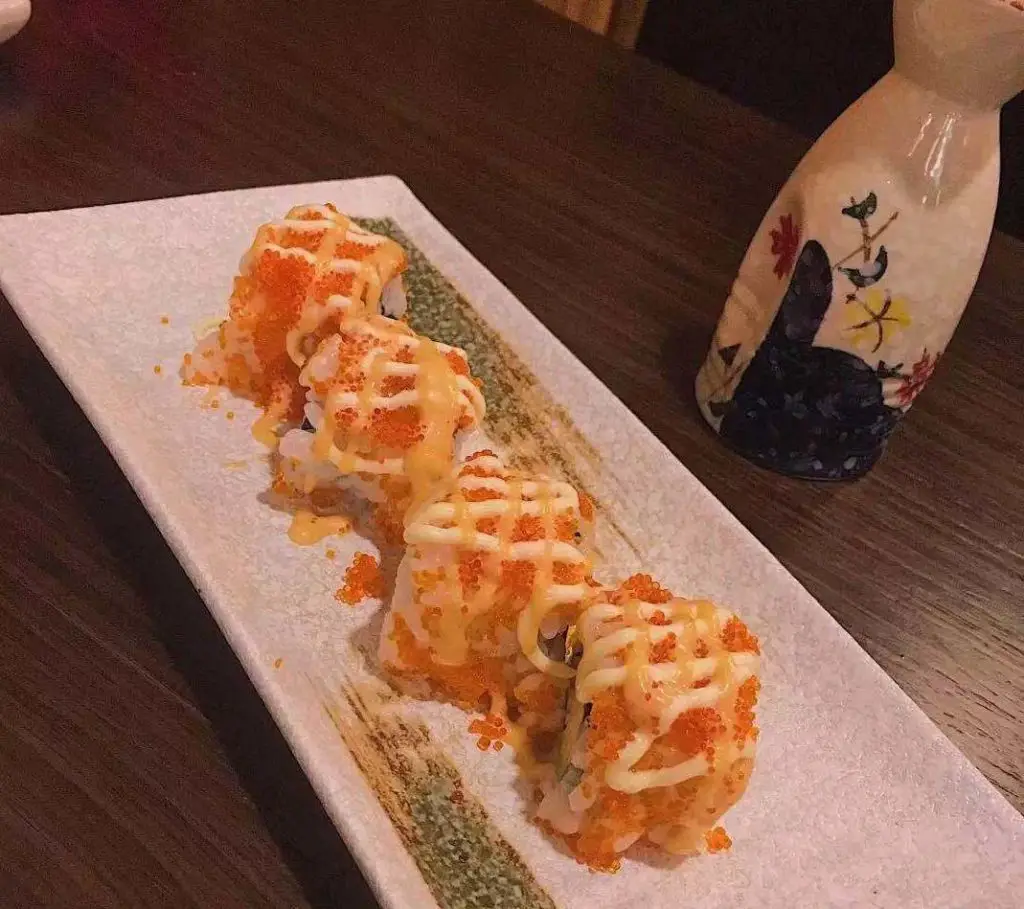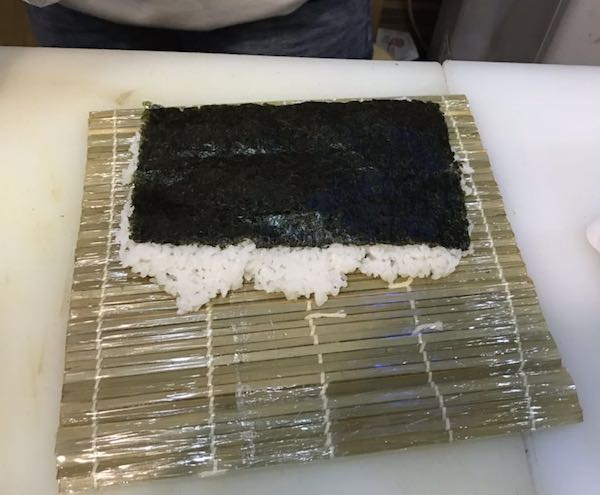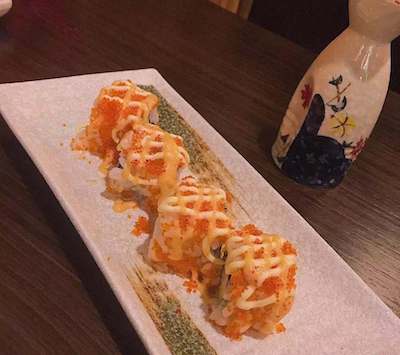We are reader supported. When you purchase through links on our site, we may earn an affiliate commission. Also, as an Amazon affiliate, we earn from qualifying purchases.

A California roll is also known as ‘makizushi sushi’ and is rolled inside-out! The main ingredients include crab (or imitation crab), cucumber and avocado. Often times the outer layer of rice is topped with toasted sesame seeds. This is one of the most common styles of sushi in North America, even though it is not really sushi at all! Which begs the question, “why is a California roll not sushi”?
Why is a California roll not sushi? Because it is made using an inside-out roll (uramaki) with the rice on the outside and it uses imitation seafood instead of raw fish as one of its main ingredients, it is often not considered to be ‘real’ sushi by Japanese standards.
However, dependent upon how ‘serious’ of a sushi eater you are, this question is open for debate. If you consider Japanese-style rolls are the only real sushi, then you will answer the above question with ‘no’. If you believe American-style rolls also qualify as sushi, then you will reply ‘yes’ to the question.
Now that you know what a California roll is, let’s explore in more detail why it is often not considered to be ‘real’ sushi. We will also discuss how to make a California roll and whether or not California rolls are actually good for you. But first, let’s begin with a little bit of history…
Who Invented the California Roll?
The California roll is believed to have been created in Canada by a Japanese-born chef named Hidekazu Tojo. This is not a proven fact, however. Chefs in Los Angeles have also laid claim to the creation of the California roll. According to Tojo, he invented the roll in Vancouver and called it the ‘California roll’ because of its growing popularity it Los Angeles during the early 1970’s.
Why are California Rolls called California Rolls?
The California roll is believed to have gotten its name after being served to Americans as sushi in a restaurant known as Tokyo Kaikan in Los Angeles in the early 1960’s. It was situated in what was known as ‘Little Tokyo’ and some believe it was Chef Ichiro Mashita (not Hidekazu Tojo, as stated above) who inadvertently created it by mistake! By not having any ‘toro’, or fatty tuna fish, on hand, he opted to use avocado as a substitute. And hence, voila, the California roll was born!
What is the difference between a California Roll and Sushi?
The differences between a California roll and traditional Japanese-style sushi include the ingredients used and the way they are made. Unlike traditional sushi, California rolls are not wrapped in seaweed. The inside-out rolls used to make them have the rice on the outside of the seaweed, which in not common in Japanese cuisine.

Another difference involves the use of ‘imitation’ sea food. California rolls will often use ‘imitation’ crab as the main ingredient. Imitation crab is made with ‘surimi’ which is a type of white fish with added fillers, flavors, and colors to mimic the taste and texture of real crab meat. Traditional Japanese sushi, however, uses real fish, usually raw, such as squid, eel, salmon, tuna and crab.
An American-style sushi roll will often use more than one type of fish and place it inside, on top and around the roll! A variety of sauces and toppings, including mayonnaise, are also added. A traditional Japanese-style sushi roll, however, will use only one type of fish and is typically served with soy sauce and wasabi.
Vegetables are important ingredients in both. The California roll tends to include simply avocado and cucumber whereas a traditional sushi roll will use those two as well as asparagus, carrots, eggplant, radishes, ‘negi’ (Japanese onions) and ‘shitake’ (Japanese mushrooms), to name a few.
Do They Have California Rolls in Japan?
Contrary to popular belief, California rolls do exist in Japan! The difference, however, is that they do not call them California rolls. In Japan, they may call them ‘makizushi sushi’ or ‘uramaki’, which is essentially made the same way, using avocado, cucumber and raw tuna or real crab (instead of imitation crab).
However, avocado in sushi is not as common in Japan as it is in the United States, and therefore may not be available in many Japanese restaurants. It is also likely that most sushi chefs in Tokyo, for example, would not use gloves to make these rolls, as they are required to do in California.
Food safety regulations in the United States requires ready-to-eat food, such as sushi, be prepared using gloves. Many Japanese sushi chefs are against this, claiming they lose the ‘feel’ necessary in preparing sushi properly. This could be seen as yet another reason why California rolls are not considered to be real sushi.
How to Make a California Roll?
A California roll is a creative American ‘twist’ on traditional Japanese sushi. It is easy and fun to make, only requiring a few simple ingredients. All you need is cold, pre-cooked vinegar-flavored rice, nori (seaweed), ripe avocado, cucumber slices (julienne style), imitation crab meat (or real cab) and toasted sesame seeds. There are ten steps to making a California roll at home. These include the following:
- Cover your sushi rolling mat with saran wrap.
- Place the seaweed (sheet of nori) on the mat, shiny side down.
- Wet your hands to keep the rice from sticking to your fingers.
- Spread a handful of rice (see how to make sushi rice) on top of the seaweed, covering it completely.
- Flip the seaweed over and place strips of avocado and cucumber in the middle.
- Apply a thin layer of mayonnaise on top of the avocado.
- Place slices of crab meat on top of the mayonnaise.
- Start to fold the sushi mat away from you, forming the roll.
- Using a knife, cut the roll in half. Place one half on top of the other and cut again, giving you six equal pieces.
- Serve the pieces on their sides, to show the ingredients, and enjoy!
You can add a bowl of soy sauce, for dipping, as well as some wasabi and pickled ginger on the side. If you like spicy food, try adding a bit of Sriracha or Red Hot sauce to the mayo inside the roll. Don’t forget the chopsticks! If chopsticks are not for you, then pick up a fork (or use your hands, if you prefer) and begin eating! Mmmm, so good…
Is a California Roll Healthy?
When eaten as part of a balanced diet and in moderation, sushi can be a healthy meal. That also includes the California roll, as it is usually low in fat and calories and contains nutritious ingredients such as avocado and crab (real crab meat is recommended over imitation crab).
A classic California roll (one, six piece serving) has approximately 255 calories, 7 grams of fat, 38 grams of carbohydrates, 6 grams of fiber and 9 grams of protein! The avocado adds a ‘good fat’ element to this meal while the sesame seeds are rich in iron and magnesium.
Another health benefit comes from the absence of raw fish. Traditional sushi uses cold, raw fish as a main ingredient. If not careful, this can increase a person’s risk of contracting a food-borne disease of parasite. California rolls are often made with imitation crab, which is pre-cooked and processed so it is safe to eat cold.
Are California Rolls Vegan and/or Gluten-Free?
Vegan sushi is gaining popularity in North America at a rapid rate. With the desire to eat healthier, California rolls, which are essentially a veggie roll with rice, avocado, cucumber and nori (seaweed), are the perfect example of a plant-based meal. The exception comes with the imitation crab, which is not vegan. To make the California roll vegan, simply omit the imitation crab.
Not all sushi is gluten-free. California rolls, because they contain imitation crab, are not gluten-free, especially if served with soy sauce. To make the meal gluten-free, omit the crab and serve with a specially-made, gluten-free soy sauce.
Conclusion
In conclusion, California rolls are the perfect example of American-style sushi. Because they use imitation crab (instead of raw fish) and are made with an inside-out roll, they are often not considered a type of sushi, by Japanese standards.
Whether or not you consider a California roll to be sushi depends upon how serious of a sushi-eater you are! If you define sushi in terms of Japanese-style cuisine, then chances are you do not consider a California roll to be sushi. However, if you include American-style rolls as part of sushi fare, then it is likely you see things differently.
Regardless of how you define sushi, California rolls are a tasty and healthy meal which can be made to suit both vegan and gluten-free diets. They are easy and fun to make so ahead and indulge in some delicious American-style sushi today. Bon apetit or ‘Itadakimasu’, in Japanese!
See more: Difference Between Japanese Sushi And American Sushi

